

Developer Guide: Developer Guide. Loading...

Improve this doc Everything you need to know about AngularJS Tutorials Core Concepts Templates In Angular applications, you move the job of filling page templates with data from the server to the client. Application Structure. Angular Basics. A directive returns an object with a variable number of properties.
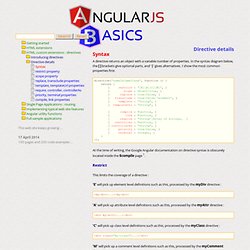
In the syntax diagram below, the [ ] brackets give optional parts, and '|' gives alternatives. I show the most common properties first. directive('nameInCamelCase', function () { return { [ restrict : '[E][A][C][M]', ] [ scope : Object|true, ] [ replace : true|false, ] [ transclude : true|false|'element', ] [ template : 'String', ] [ templateUrl : 'String', ] Developer Guide: Introduction. Loading...
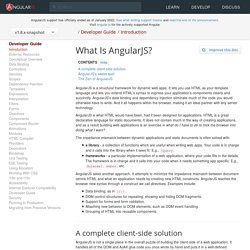
AngularJS is a structural framework for dynamic web apps. It lets you use HTML as your template language and lets you extend HTML's syntax to express your application's components clearly and succinctly. Angular's data binding and dependency injection eliminate much of the code you would otherwise have to write. And it all happens within the browser, making it an ideal partner with any server technology. Angular is what HTML would have been, had it been designed for applications.
The impedance mismatch between dynamic applications and static documents is often solved with: Diving deep into the AngularUI Router. AngularJS is packed with out-of-the-box features that we can use to build an expressive AngularJS app without relying on separate libraries; however, the very active AngularJS community has also built some great libraries that we can take advantage of to maximize the power of our apps.
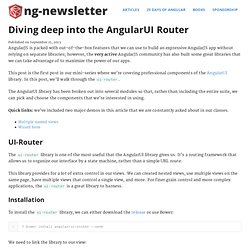
This post is the first post in our mini-series where we’re covering professional components of the AngularUI library. In this post, we’ll walk through the ui-router. The AngularUI library has been broken out into several modules so that, rather than including the entire suite, we can pick and choose the components that we’re interested in using. Quick links: we’ve included two major demos in this article that we are constantly asked about in our classes. The ui-router library is one of the most useful that the AngularUI library gives us. How to Learn AngularJS - Your AngularJS Sherpa. Learning AngularJS can be complex.

There are an overwhelming number resources available on the web. The blog posts can be conflicting and confusing, and a simple google search can turn up 5 articles all describing the same thing in a completely different way. How To Use AngularJS and Keep Loving Rails. My Approach I love writing Ruby and I love using Rails.
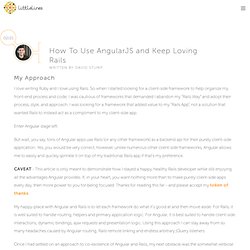
So when I started looking for a client-side framework to help organize my front-end process and code, I was cautious of frameworks that demanded I abandon my "Rails Way" and adopt their process, style, and approach. I was looking for a framework that added value to my "Rails App", not a solution that wanted Rails to instead act as a compliment to my client-side app. Enter Angular stage left. Implementing a Flowchart with SVG and AngularJS. Download FlowChart.zip - 305.2 KB Contents Overview This article documents the development of a small exploratory project for flowchart visualization and editing that is built upon SVG and AngularJS.
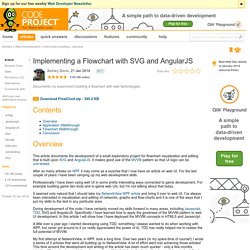
It makes good use of the MVVM pattern so that UI logic can be unit-tested. AngularJS Hangout - Promises, Promises. Services/Factories. Egghead.io: Learn AngularJS with Tutorial Videos & Training - @eggheadio. How to integrate AngularJS with Rails 4 - Blog - Shelly Cloud. Building most single-page applications (SPAs for short) is a two-step process: first you create a JSON API in a backend technology of choice and then you use that API in the JavaScript application.

Here we'll be using Ruby on Rails on the backend and AngularJS on the frontend. The main pain point of any kind of integration is making sure that everything fits together well. This post will not take you through building the whole application. Instead, it will focus on making sure all the integration points are handled properly. I will also share with you some practical advice on the topic. Code examples used in this post come from a Todo list management application.
Bootstrapping an AngularJS app in Rails 4.0 - Part 1. The full GitHub repository for this tutorial is available here Introduction I was in the process of building a blog for myself as an exercise to try out Rails 4.0.
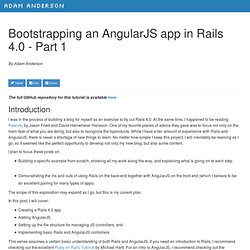
At the same time, I happened to be reading Rework, by Jason Fried and David Heinemeier Hansson. One of my favorite pieces of advice they gave was to focus not only on the main task of what you are doing, but also to recognize the byproducts. While I have a fair amount of experience with Rails and AngularJS, there is never a shortage of new things to learn. I plan to focus these posts on: Building a specific example from scratch, showing all my work along the way, and explaining what is going on at each step.Demonstrating the ins and outs of using Rails on the back end together with AngularJS on the front end (which I believe to be an excellent pairing for many types of apps) The scope of this exploration may expand as I go, but this is my current plan.